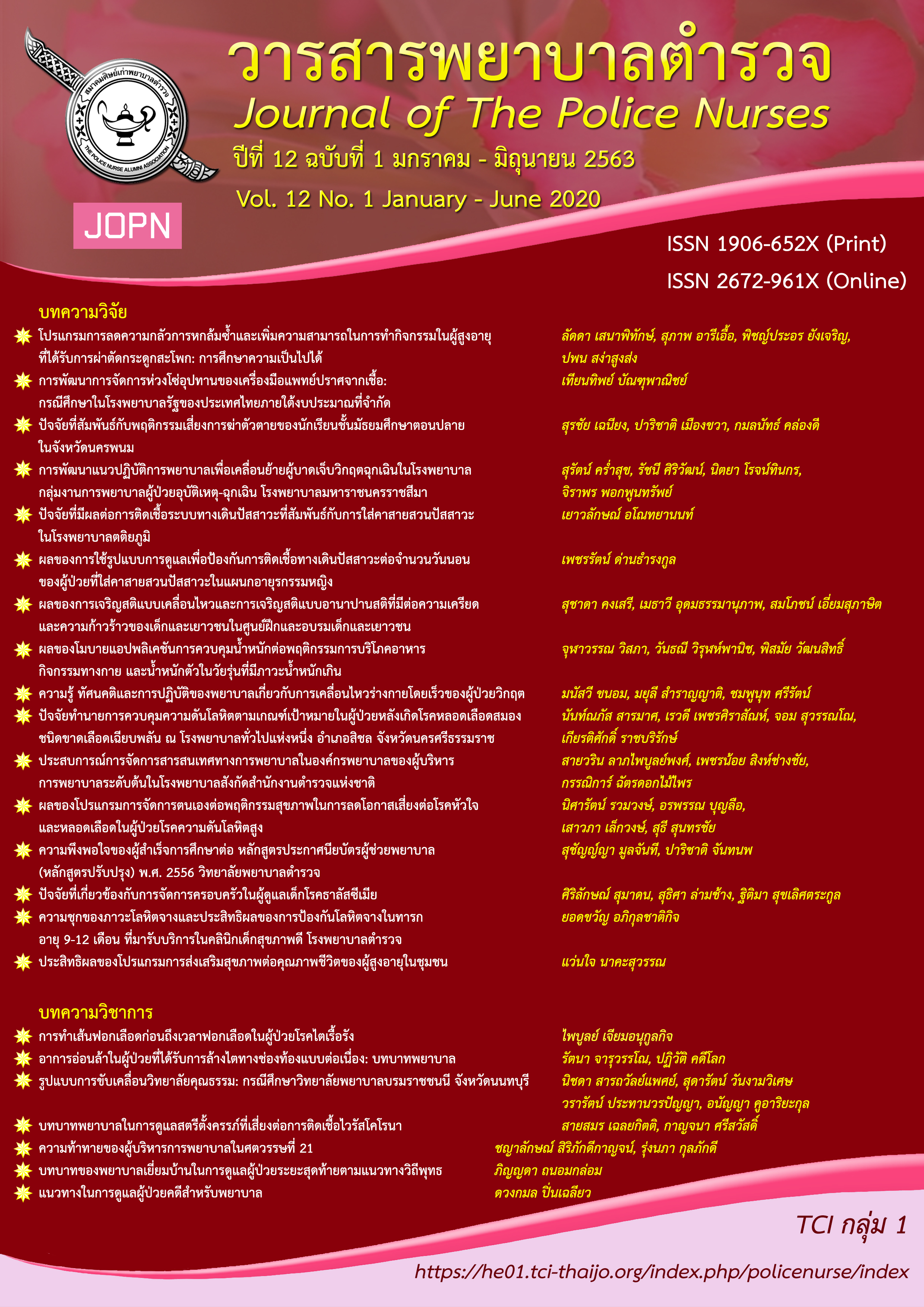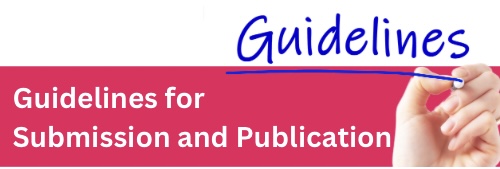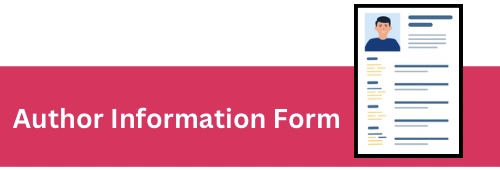FACTORS RELATED TO FAMILY MANAGEMENT AMONG CAREGIVERS OF CHILDREN WITH THALASSEMIA
Keywords:
family management, caregivers of children with thalassemiaAbstract
The purposes of this descriptive correlational research were to study family management and examine the factors related to family management in caregivers of children with thalassemia. The sample was comprised of primary caregivers of children with thalassemia aged from 6 to 15 years old who continuously attended hematology clinics at the pediatric out-patient departments at Maharaj Nakhon Chiangmai Hospital, Lampang Hospital and Phayao Hospital during December 2019 to January 2020. The study sample was selected by purposive sampling of 85 caregivers of children with thalassemia. The research instruments consisted of the Caregivers and Children's Personal Information Questionnaire, the Social Support Questionnaire, tested for reliability with value of .88, the Family Management Measure, tested five dimensions for reliability with value of .83, .82, .83, .89 and .82 respectively. Data were analyzed using descriptive statistics, eta coefficient, Pearson’s correlation coefficient and Spearman’s rank correlation coefficient.
The results of the study revealed that: 1) The total family management among caregivers of children with thalassemia with five dimensions scores were at a moderate level. The result of easy and difficult family management. The result shows that all caregivers of children with thalassemia have an easy managing their family. 2) Education level of caregivers and income had a positive, statistically significant correlations with conditional management ability at a moderate level (η=.45, p=001 and η=.34, p=.017, respectively). The total social support had a positive, statistically significant correlation with child’s daily life at a moderate level (r=.45, p=.000), and conditional management ability at a high level (r=.59, p=.000). The total social support had a negative statistically significant correlation with family life difficulties at a moderate level (r=-.36, p=.000).
Downloads
References
Chusri, O., Deoisres, W., & Riper, M. V. (2016). The style of managementin families having a child with thalassemia. SDU Research Journal Sciences and Technology, 9(3), 111-125.
Chusri, O., Deoisres, W., & Riper, M. V. (2019). Influencing of family management in families with thalassemia children on health-related quality of life and family functioning: SEM approach. Walailak Journal, 16(1), 27-38.
Department of Medical Service, Ministry of Public Health. (2018). Thalassemia news. Retrieved from www.dms.moh.go.th.
Fongkerd, S., & Himananto, S. (2016). Family nursing. Chonburi: Sri Art Printing house.
Gharaiben, H., Amarneh, B. H., & ZamZam S. Z. (2009). The psychological burden of patients with beta thalassemia major in Syria. Acta Paediatrica Japonica, 51(5), 630-636. Retrieved from https://www.ncbi.nlm.nih.gov/pubmed/19419527
Grey, M., Knafl, K., & McCorkle, R. (2006). A framework for the study of self-and family management of chronic conditions. Nursing Outlook, 54(5), 278-286. doi: 10.1016/j.outlook.2006.06.004
House, J. S. (1981). Work stress and social support. New Jersey, NJ: Prentice Hall.
Jetsrisuparb, A. (2009). Holistic in thalassemia. Khon Kaen:Khon Kaen publishing.
Kahn, R. L., Goldfarb, A. I., Pollack, M. & Peck, A. (1960). Brief objective measures for the determination of mental status in the aged. American Journal of Psychiatry, 117, 326-328.
Kim, D. H., & Im, Y. J. (2015). The influence of family management style on psychosocial problems of childhood cancer survivors in Korea. European Journal of Oncology Nursing, 19(2), 107-112. doi: 10.1016/j.ejon.2014.10.010
Knafl, K. A., Deatrick, J. A., Knafl, G. J., Gallo, A. M., Grey, M., & Dixon, J. (2013). Patterns of family management of childhood chronic conditions and their relationship to child and family functioning. Journal of Pediatric Nursing, 28(6), 523-535. doi: 10.1016/j.pedn.2013.03.006
Kuhlthau, K., PayaKachat, N., Delahaye, J., Hurson, J., Pyne, J. M., Kovacs, E., & Tilford, J. M. (2014). Quality of life for parents of Children with autism spectrum disorders. Research in Autism Spectrum Disorders, 8(10), 1339-1350.
Maharsaro, P., Suwonnaroop, N., & Watthayu, N. (2017). Factors predicting caring behaviors among caregivers of 1-6 years old asthmatic children. Journal of Nursing Science, 35(2), 64-73.
Mazzone, L., Battaglia, L., Andreozzi, F., Romeo, M. A., & Mazzone, D. (2009). Emotional impact In -Thalassemia major children following cognitive-behavioural Family therapy and quality of life of caregiving mothers. Children Practice and Epidermiology in Mental health, 5(5), 1-6. doi: 10.1186/1745-0179-5-5
Mettananda, S., Gibbons, R. J., & Higgs, D. R. (2015). α-Globin as a molecular target in the treatment of β -thalassemia. Blood Journal, 125(24), 3694-3701. doi: 10.1182/blood-2015-03-633594
Mukrod, S. (2008). Effect of supportive nursing system on maternal care behavior and self-care behaviors of school age children with thalassemia (Master of Nursing Science in Pediatric Nursing). Faculty of Graduate Studies, Chulalongkorn University, Bangkok.
Naka, P., Wannapornsiri, C., & Santayakorn, S. (2009). Family experience on caring children with thalassemia. Journal of nursing science Naresuan University, 3(2), 117-131.
Nigam, N., Nigam, S., Agarwal, M., & Singh, P. K. (2017). β-thalassemia:From clinical symptoms to the management. International Journal of Contemporary Medical Research, 4(5), 1066-1070. Retrieved from https://www.ijcmr.com/uploads/7/7/4/6/77464738/ijcmr_1446_june_14.pdf
Nookong, A., Payakkaraung, S., Pongsaranuntakul, Y., & Chudapongse, S. (2012). Caregivers' management for children with asthma. Journal of Nursing Science, 30(1), 49-60.
Polit, D. F. (2010). Statistic and data analysis for nursing research (2nd ed.). New Jersey, NJ: Pearson Education Inc.
Poompu, B., & Hornboonherm, P. (2018). Self-care behaviors in school age patient with chronic illness. Journal of Mahasarakham University, 14(1), 14-23.
Pouraboli, B., Abedi, H. A., Abbaszadeh, A., & Kazemi, M. (2017). The burden of care: Experience of parents of children with Thalassemia. Journal of Nursing and Care, 6(2), 1-8. doi: 10.4172/2167-1168.1000389
Sananreangsak, S., Lapvongwatana, P., Virutsetazin, K., Vatanasomboon, P., & Gaylord, N. (2012). Predictor of family management behavior for children with thalassemmia. The Southeast Asian Journal of Tropical Medicine and Public Health, 43(1), 160-171.
Sanguansermsri, T. (2014). Thalassemia carrier. Journal of Hematology and Transfusion Medicine, 24(4), 329-332.
Sheng, N., Ma, J., Ding, W., & Zhang, Y. (2017). Cluster analysis for family management of Chinese children with chronic kidney diseases. Journal of Health Psychology, 2017, 1-11.
Sheng, N., Ma, J., Ding, W., & Zhang, Y. (2018). Family Management affecting transition readiness and quality of life of Chinese children and young people with chronic diseases. Journal of Child Health Care, 2018, 1-16.
Siddiqui, M. M., Rehman, F. U., Nazir, I., Khan, M. M., Zafar, S., Ali Ch, Z., & Qadir, I. (2015). Thalassemia major impact on patient’s families in Notthern Punjab, Pakistan. Pakistan Journal of Medical and Health Sciences, 9(3), 870-874.
Sleiman, J., Tathini, A., Bou-Fakhredin, R., Saliba, A. N., Cappellini, M. D., & Taher, A. T. (2018). Non-transfusion-dependent thalassemia: An update on complications and managemant. International Journal of Molecular Sciences, 182(19), 1-16. doi: 10.3390/ijms19010182
Thongsamrit, N., & Chandarasiri, P. (2016). Psychosocial status among mothers of children with chronic lung disease. Chulalongkorn Medical Journal, 60(5), 575-588.
Viprakasit, V. (2013). Comprehensive management for thalassemia. Journal of Hematology and Transfusion Medicine, 23(2), 303-319.
Wattana, S. (2018). Factors related to family management in families having children with congenital heart disease (Master of Nursing Science in Pediatric Nursing). Faculty of Graduate Studies, Chiang Mai University, Chiang Mai.
Wattananonsatien, W., & Plapo, M. (2018). the effect of discharge planning for school age children with thalassemia using D-M-E-T-H-O-D model on knowledge and practice. Kuakarun Journal of Nursing, 25(2), 78-90.
Yildiz, A., Celebioglu, A., & Olgun, H. (2009). Distress levels in Turkish parents of children congenital heart disease. The Australian Journal of Advanced Nursing, 26(3), 39-46.
Yusuk, P. (2019). Factors related to maternal management for children with thalassemia. Journal of The Police Nurses, 11(1), 151-162.
Zhang, Y., Wei, M., Shen, N., & Zhang, Y. (2015). Identifying factors related to family management during the coping process of families with childhood chronic conditions: A multi-site study. Journal of Pediatric Nursing, 30(1), 160-173. doi:10.1016/jpedn. 2014.10.002
Downloads
Published
How to Cite
Issue
Section
License
ผลงานที่ได้ตีพิมพ์แล้วจะเป็นลิขสิทธิ์ของวารสารพยาบาลตำรวจ















